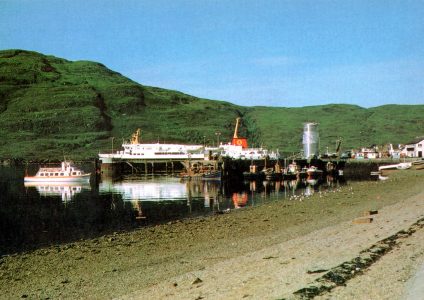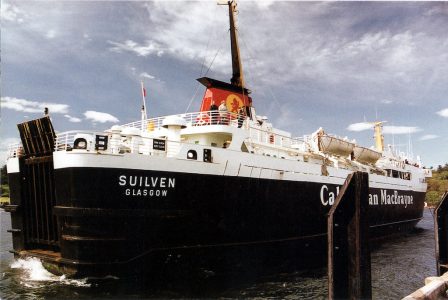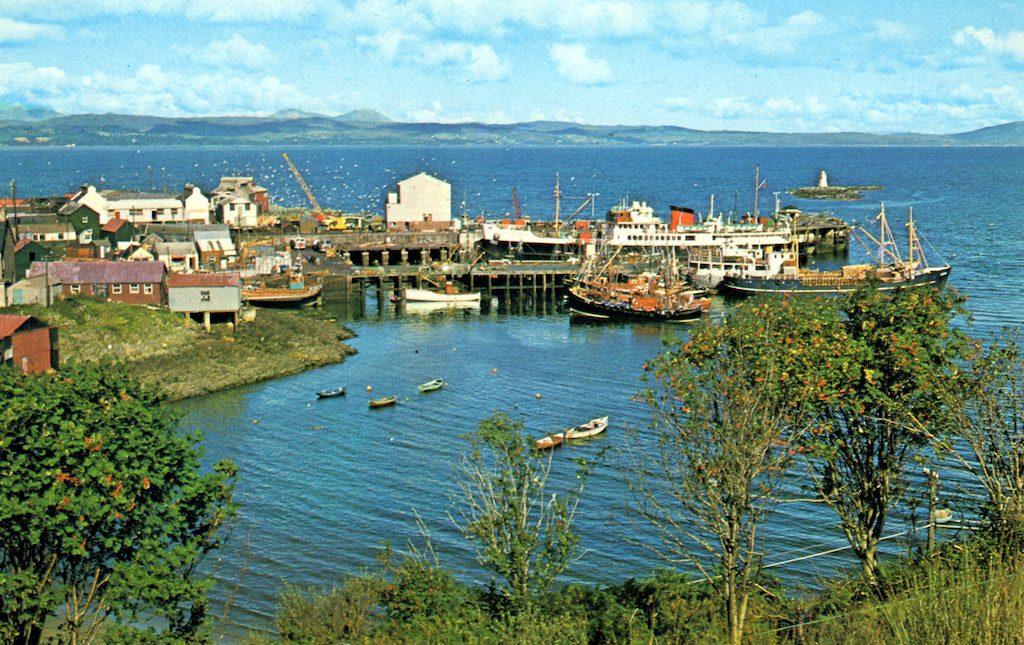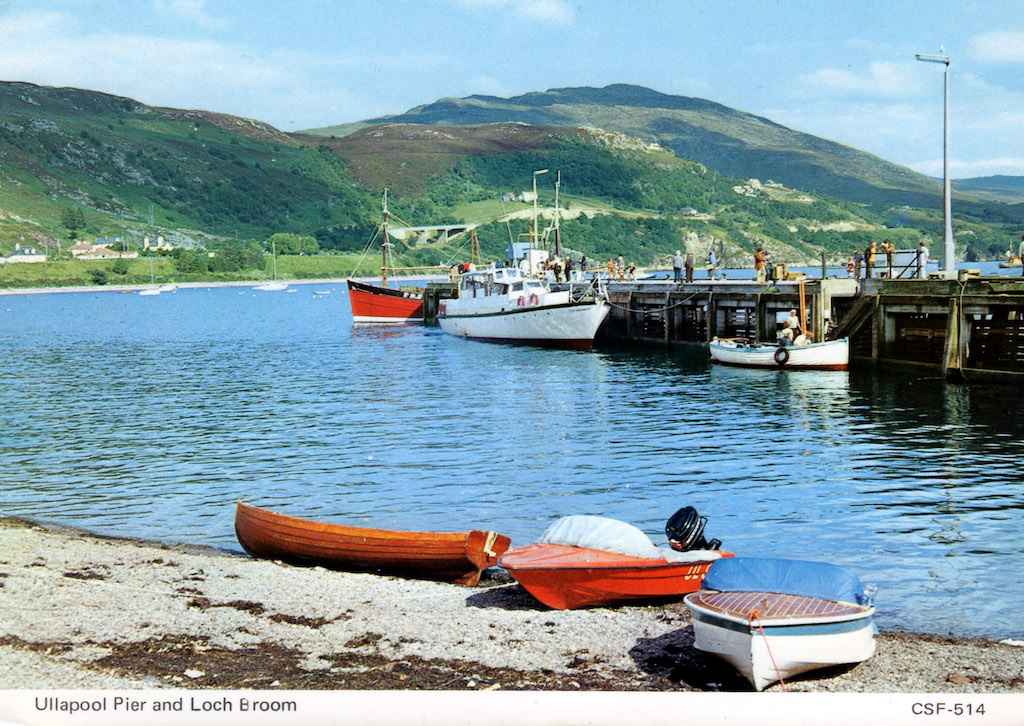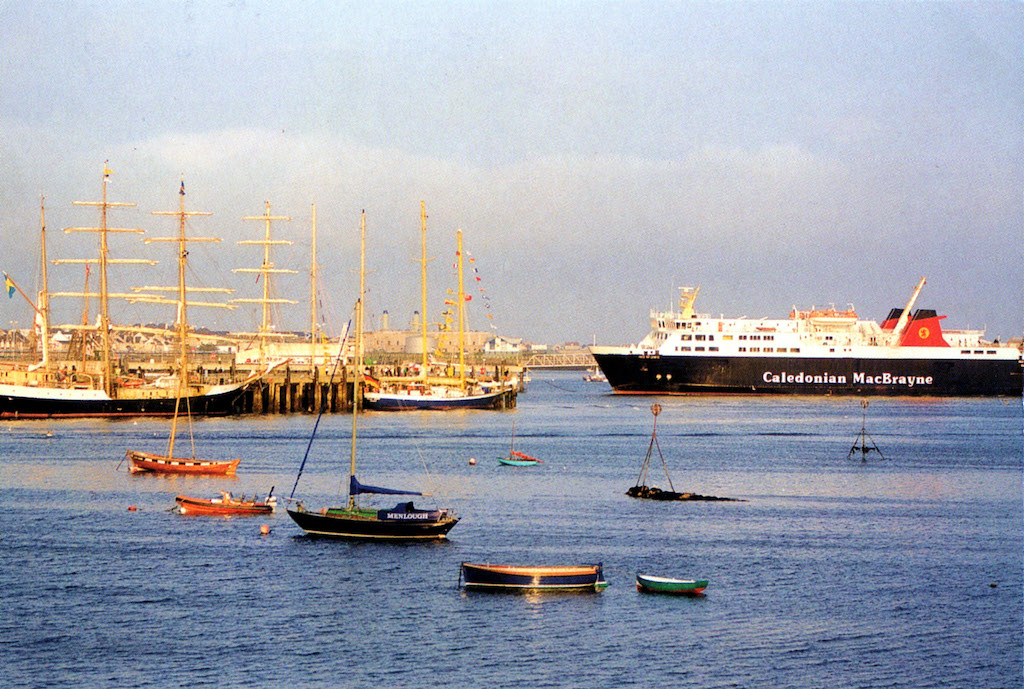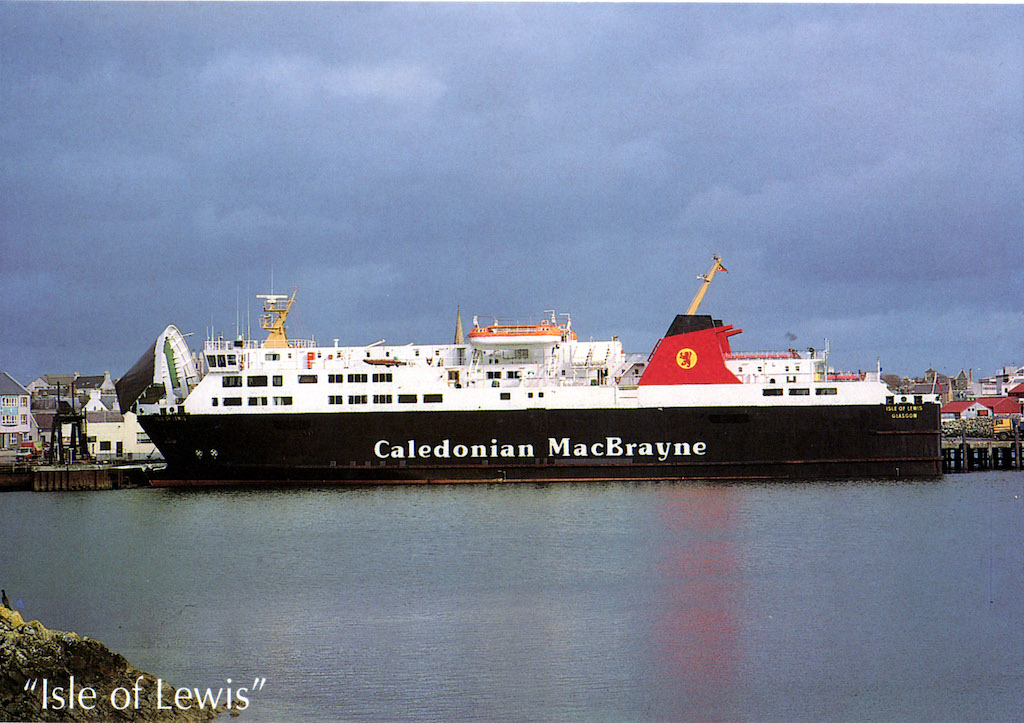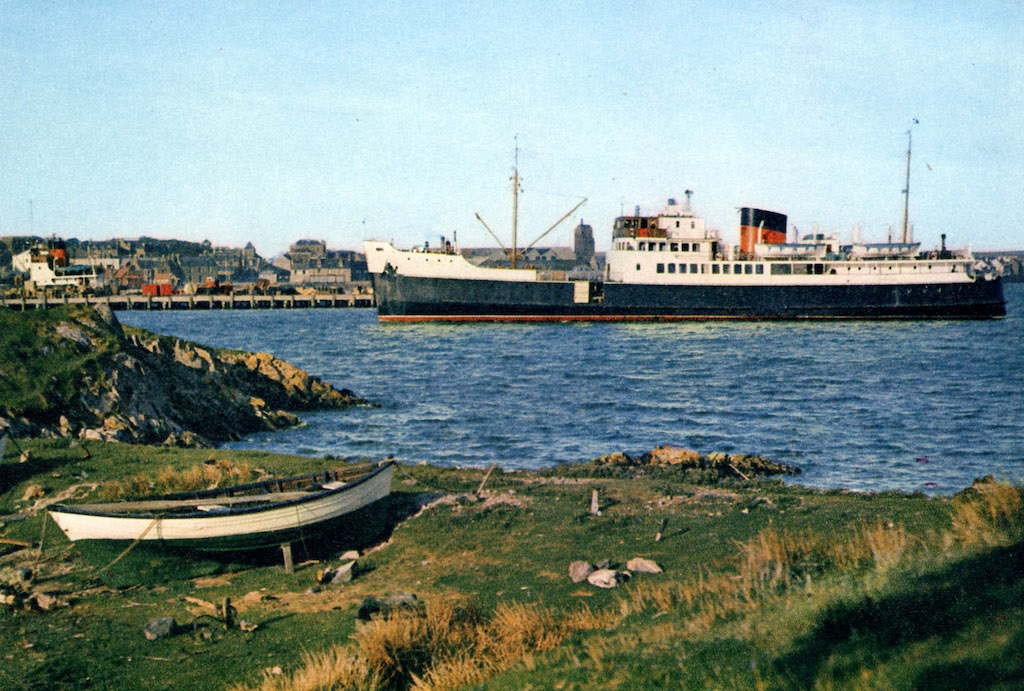
A feature of some of the early postcard views of the 1947 Loch Seaforth was her unnatural positioning in the middle of Stornoway Harbour — edited, as here, in a way that shows her in motionless pose next to the beached wooden skiff in the foreground. This classic J Arthur Dixon postcard includes MacBraynes’ Glasgow-Stornoway cargo ship Lochdunvegan on the far left
John Park continues his exploration of picture postcards showing ships and scenes associated with a particular route. Following his earlier focus on the Uig triangle, he homes in on the farthest-flung route of the Clyde/Hebridean network — while noting that, due to waning demand for postcards in our era of instant digital communication, the current Loch Seaforth features little in his account.
The postwar Stornoway service can be neatly split into its two distinct phases, with the original service to Kyle of Lochalsh and Mallaig being replaced by the shorter crossing to Ullapool in 1973.
The introduction of Loch Seaforth in 1947 makes a useful starting point for illustrating the service in picture postcards: there is more to some of the Stornoway cards than initially meets the eye.
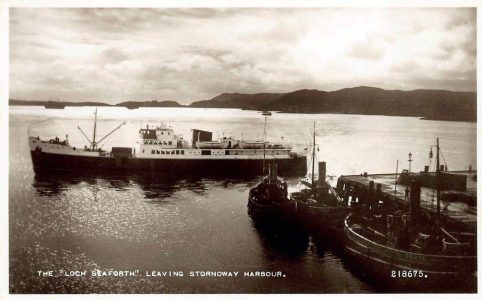
A Valentines portrait of Stornoway Harbour from around 1948, showing Loch Seaforth with her original squat funnel and thin black top
Valentines of Dundee were quick to publish two early views of the ‘Seaforth’ at Stornoway, taken during her first year in service with shorter-length funnel. A close inspection of these views seems to place the vessel in unusual positions relative to harbour landmarks. One card shows her at right angles to the end of No. 1 pier with her bows pointing towards No. 2 pier, while the other has her lying a long way off No. 1 pier and quite clearly not under way. Some clever editing has been taking place!
Cards from other publishers feature this same editing trick, including the well known J Arthur Dixon postcard of Loch Seaforth and Lochdunvegan together either side of No. 1 pier. An unknown publisher managed to go one better than the Dixon view by capturing both MacBrayne ships plus a Coast Lines vessel all in the same shot. Again, both views show Loch Seaforth in what appears to be a slightly false position.
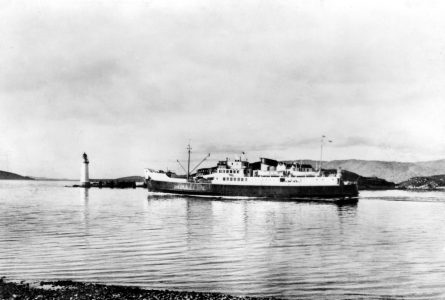
Another Valentines card shows Loch Seaforth in the 1950s, now with thick black funnel top, heading out past Eilean Ban Lighthouse on her way to Stornoway
It was not uncommon for publishers to alter a photograph like this, but it does seem unusual for similar views by different publishers to be edited in exactly the same way.
Another Dixon card captures an unusual meeting between the Scottish Fishery Protection cruiser Ulva and the Royal Research Ship (RRS) Discovery. The latter came from the yard of Hall Russell of Aberdeen in 1962 and spent much of her 50 years in service in foreign waters so her visit to Stornoway would have been a particularly rare event. She underwent a major rebuild in 1992, which altered her appearance beyond all recognition, She was finally retired in 2012.
Both Dixon views were taken by local photographer James Rodger, who has supplied other local photographs for this publisher, so the editing in some or possibly all of the Loch Seaforth postcards may be his handiwork.
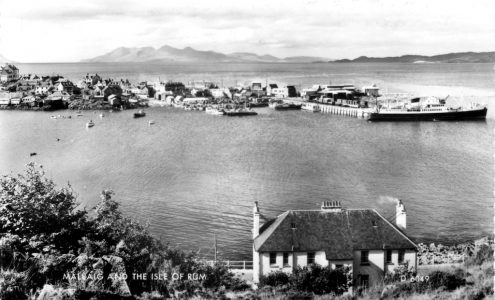
Valentines also issued this view of Mallaig Harbour with Loch Seaforth lying peacefully at the quayside and Skye’s Sleat peninsula on the right. The peaks of Rum provide an impressive background — in many ways the classic Mallaig view, though the harbour at that time was still relatively undeveloped. Loch Seaforth traditionally arrived from Stornoway in the morning and left for the return sailing after midday
There was a similar issue of new cards across the Minch at Kyle of Lochalsh, where several publishers produced black and white views of Loch Seaforth early in her career. Later colour postcards often featured the ‘Seaforth’ sharing a busy scene with various members of the CSP’s Skye Ferry flotilla.
A lovely example of this is a W S Thomson of Fort William postcard which shows Loch Seaforth berthed at the pier with what looks like Loch Toscaig alongside, while in the foreground one of the 1950s pair Portree or Broadford is busy at the slipway unloading a classic Duple Vega coach. This style of coach was common in the MacBraynes bus fleet for many years.
My personal favourite is an A D Henderson of Maybole postcard taken from Kyleakin, which shows Loch Seaforth sweeping away from the pier and heading home towards Stornoway. At least three Skye ferries are also in this view, along with a similar number of MacBraynes buses parked on the slipway at Kyleakin. A small number of traditional fishing boats add to the period charm of this delightful afternoon scene.
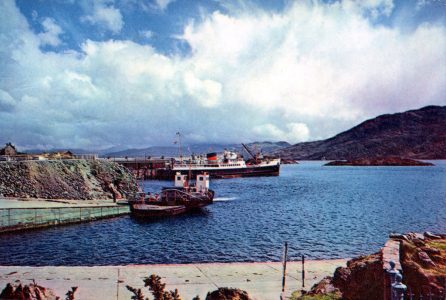
A Harvey Barton postcard showing Loch Seaforth at Kyle of Lochalsh, with a Skye turntable ferry in the foreground
And something of a rarity from Colourmaster was a later view taken from the same general area as the Henderson card but this time featuring Iona berthed at Kyle. The turntable ferries have been replaced by the 1970s pair Lochalsh (at the slipway) and Kyleakin, while the colourful MacBraynes buses on the slipway have been superseded by two Highland Omnibus vehicles. This dates the photo to 1972 and is the only card I have found of Iona on the Stornoway service.
Mallaig always offered a good selection of ferry postcards, but only Valentines and Colourmaster seem to have published cards featuring Loch Seaforth. Valentines issued a number of black and white cards, with at least two of the views taken early in her career. Colourmaster published two colour postcards of the ‘Seaforth’ at Mallaig, including a later view when she sported a narrower black band atop her funnel.
It was all change when the Stornoway service switched to Ullapool in 1973. There was little in the way of ship postcards at the Wester Ross port other than the resident fishing fleet, although the much travelled Etive Shearwater put in a couple of appearances in cards by J Arthur Dixon and Charles Skilton during her time there.
Clansman’s short-lived period on the Stornoway service gave publishers little time to update their range of cards, so views of her at either port are thin on the ground. The only postcard I have of Clansman during her brief spell on the route is a distant panoramic view of Ullapool published by the Natural History Centre at Ardnamurchan, although I suspect there may be one or two other cards out there still waiting to be discovered.
The introduction of Suilven in 1974 brought long term stability back to the Stornoway route, and a good number of postcards of her became available during her 21-year career serving Lewis.
The pick of the cards featuring Suilven at Stornoway are any of those issued by Jarrolds, Sue Anderson Photography and Orkney-based CTP Publishing, while she also appeared in several multi-view postcards issued by various publishers.
Over at Ullapool there was a good selection of cards published by the likes of NPO Dexter of Belfast and Braemar Films of Duns. However the most attractive views were probably two cards published by the ever reliable J Arthur Dixon.
The publication of special collector cards became increasingly popular from the 1970s onwards and Suilven features a number of times in various card series. CalMac themselves have issued more than one set of collector cards over the years. As most readers will probably be familiar with these collector cards, they have not been included in this article.
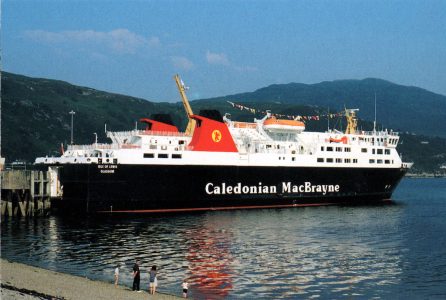
Brand new and dressed overall to mark her entry into service, Isle of Lewis makes an impressive sight from the Ullapool shoreline in this CalMac postcard from the summer of 1995
One worthwhile exception to this rule is a CalMac postcard of Isle of Lewis at Ullapool. Brand new and dressed overhaul to mark her entry into service, she looks most impressive viewed from the Ullapool shoreline. However, other publishers don’t seem to have shared this enthusiasm for Isle of Lewis, and regular postcards from Ullapool have generally been distant views only.
There was a better selection of views at her home port with cards issued by Island Blue and CTP Publishing, among others. Sue Anderson Photography was particularly busy, issuing at least four different cards of the ‘Lewis’ arriving at and departing from Stornoway.
Postcard views featuring the latest Loch Seaforth have been slower in appearing than in the past, perhaps indicating less of a demand for traditional picture postcards. Island Blue seems to have been the first publisher to issue cards of the new ‘Seaforth’, with a dramatic winter view of her in Loch Broom plus an “MV Loch Seaforth” multiview card featuring four views of the ferry.
Postcard Postscript – J Arthur Dixon
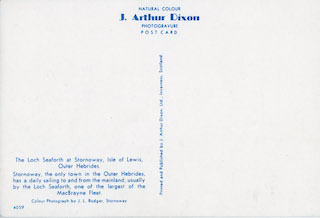 Yorkshire-born John Arthur Dixon formed the Isle of Wight based company in 1926, although postcard production did not commence until 1947. The business opened large printing premises at Longman, Inverness, in 1956 when annual postcard production was in the region of 30m. The Inverness plant produced most of the Dixon postcard and illustrated guide book ranges for its UK market until the factory closed in 1981.
Yorkshire-born John Arthur Dixon formed the Isle of Wight based company in 1926, although postcard production did not commence until 1947. The business opened large printing premises at Longman, Inverness, in 1956 when annual postcard production was in the region of 30m. The Inverness plant produced most of the Dixon postcard and illustrated guide book ranges for its UK market until the factory closed in 1981.
The business was acquired by the Dickinson Robinson Group in 1974 resulting in the group name, and latterly the letters DRG, being added to later versions of the familiar blue logo on the back of postcards. The business subsequently changed hands several times before becoming part of the John Hinde publishing Group in 1998. Sadly it ceased trading altogether in 2000.
If you have a collection of postcards illustrating the history of a particular route, and would like to write about it, please email info@crsc.org.uk
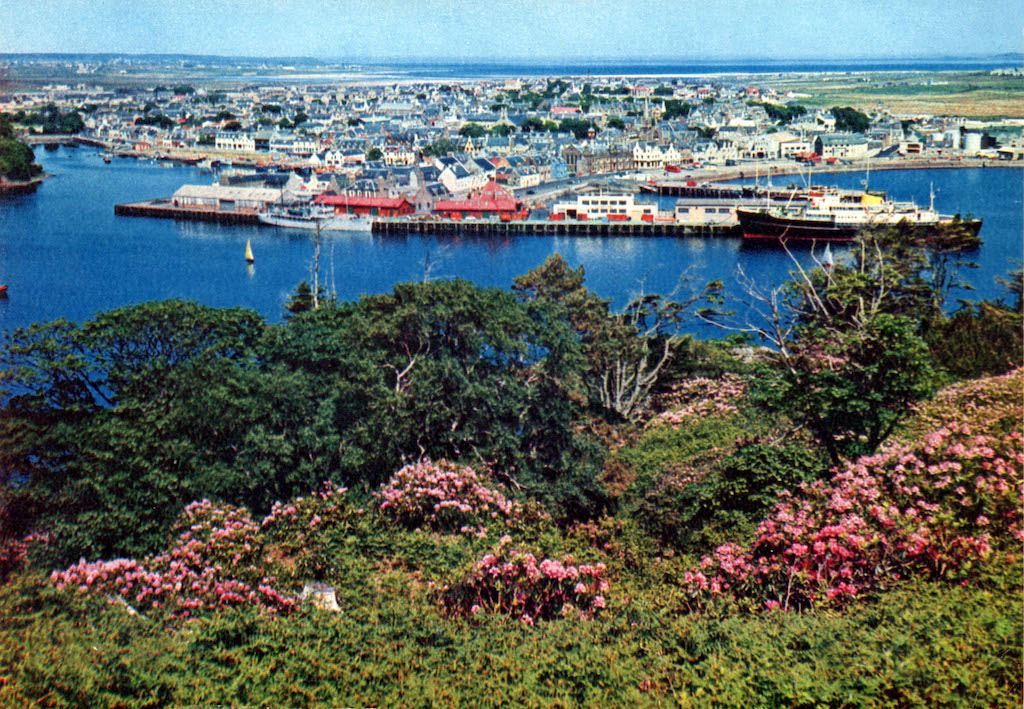
This picturesque view of Stornoway and its harbour, one of the lesser known Dixon cards, captures an unusual meeting between the Scottish Fishery Protection cruiser Ulva and the Royal Research Ship (RRS) Discovery. The latter came from the yard of Hall Russell of Aberdeen in 1962 and spent much of her 50 years in service in foreign waters so her visit to Stornoway would have been a particularly rare event. She underwent a major rebuild in 1992 which altered her appearance beyond all recognition before finally being retired in 2012
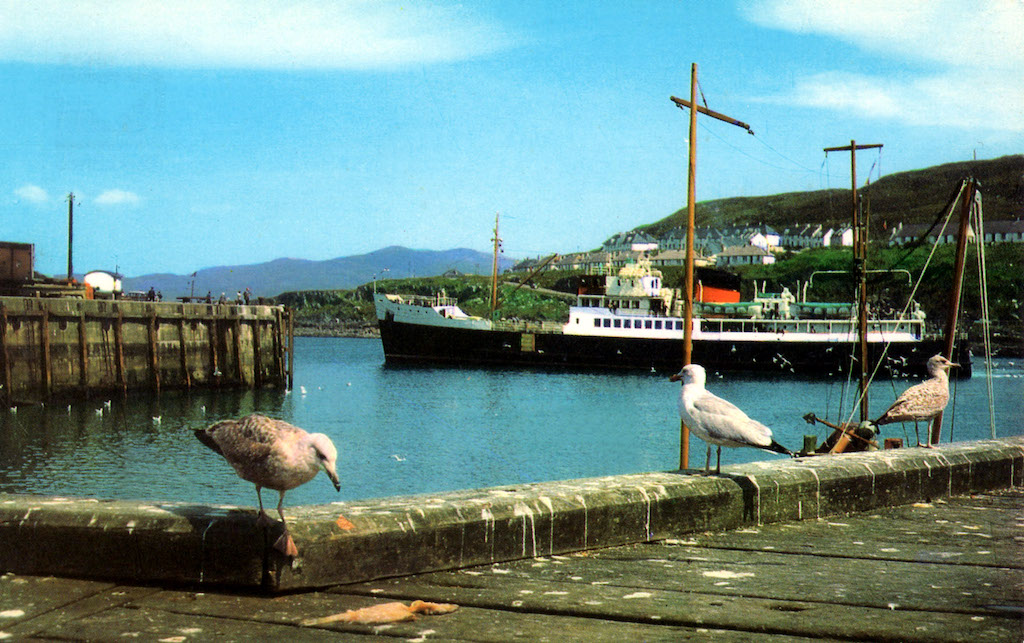
The seagulls almost steal the limelight in this Colourmaster view of Loch Seaforth at Mallaig. It shows the vessel with wide black funnel top, in which condition she appeared from May 1949 until February 1966
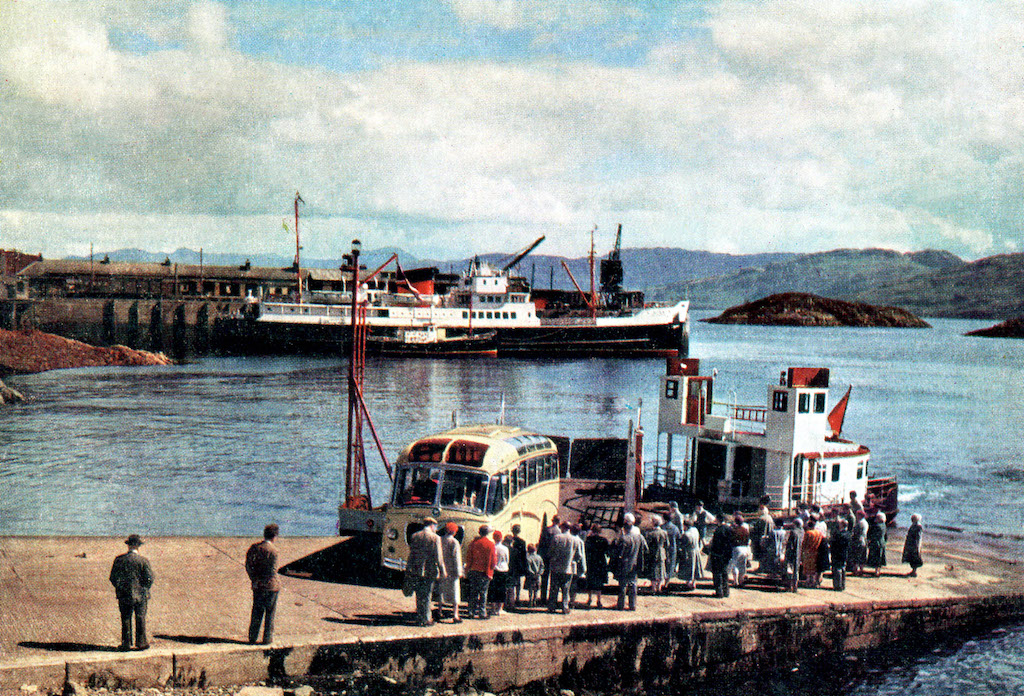
A popular Thomson card showing Loch Seaforth berthed at Kyle of Lochalsh with what looks like Loch Toscaig alongside her, while in the foreground one of the 1950s pair Portree or Broadford is busy at the slipway unloading a classic Duple Vega coach. This style of coach was common in the MacBraynes bus fleet for many years

‘One of my personal favourites is an A D Henderson postcard taken from Kyleakin, which shows Loch Seaforth heading home towards Stornoway, as well as three Skye ferries and a similar number of MacBrayne buses’. The ‘Seaforth’ was moved to Oban in 1972 and had a tragic end: she hit a rock in Gunna Sound on 22 March 1973, sank at Tiree and had to be raised and towed to Troon for breaking up
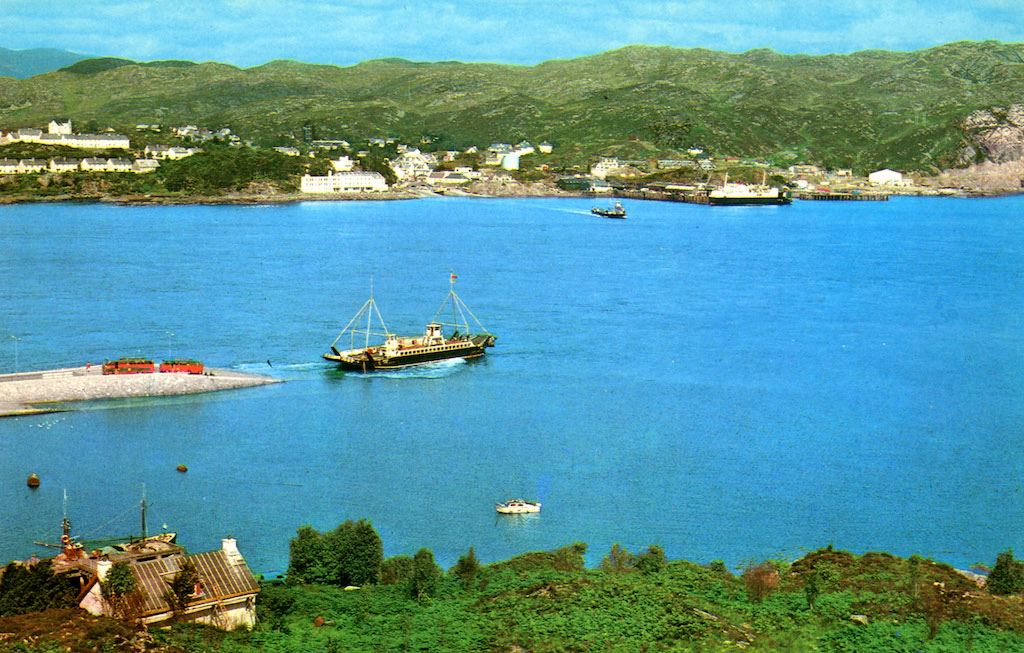
Roughly the same view, but much more of a rarity: Iona at Kyle of Lochalsh in 1972, with the new double-masted Skye ferry Lochalsh in the foreground. The Ailsa-built ferry took over the Mallaig-Kyle-Stornoway service in May 1972, and when the mainland terminal was moved to Ullapool in March 1973, she inaugurated the direct crossing to the Lewis capital until the elongated Clansman appeared at the end of June

‘Clansman’s short-lived period on the Stornoway-Ullapool service gave publishers little time to update their range of cards, so views of her at either port are thin on the ground’: this panoramic view of Ullapool is one of the few
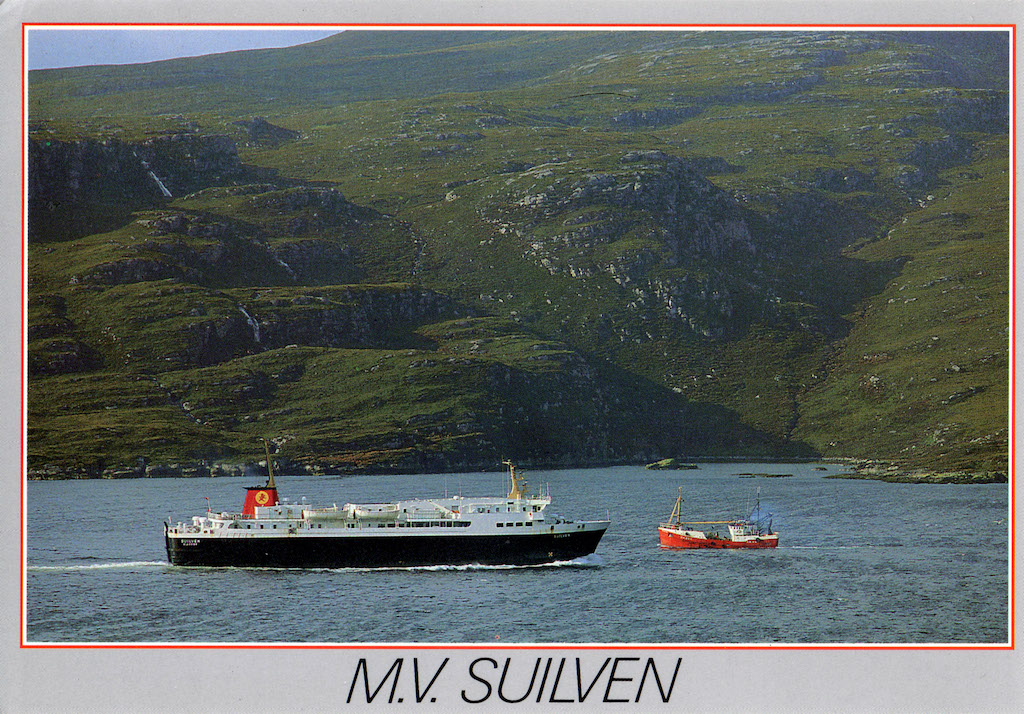
New ferry on the Stornoway run, new postcard: Suilven captured in Loch Broom by J Arthur Dixon in the mid 1970s
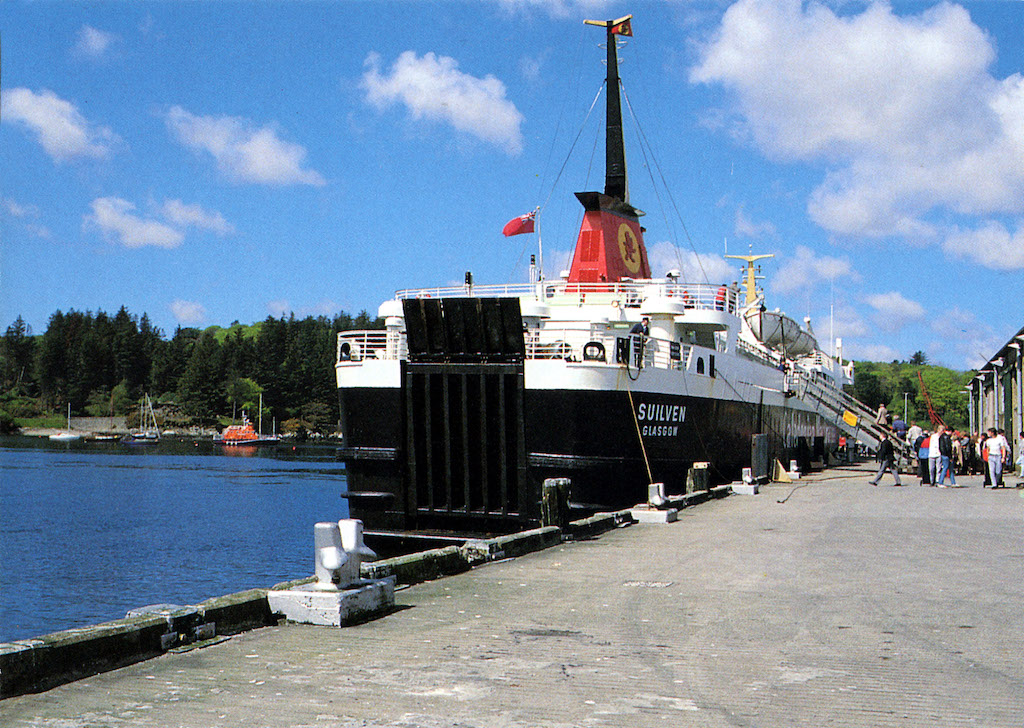
An attractive Jarrold postcard profiling Suilven’s stern section at Stornoway, including her distinctive funnel and mast
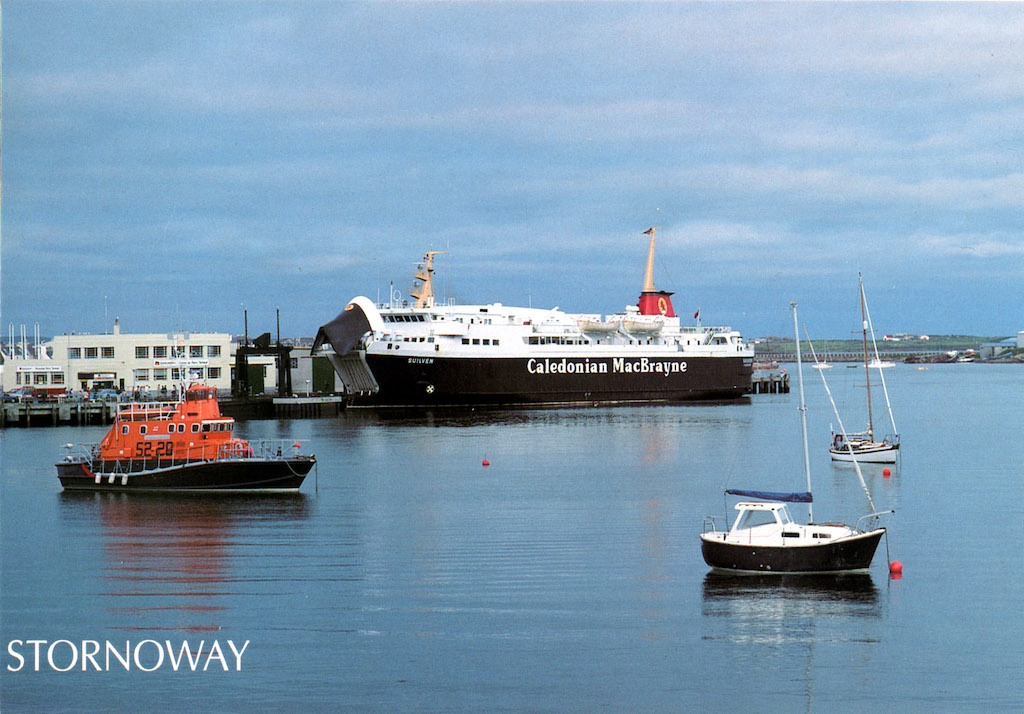
This card by Orkney-based CTP Publishing captures the well-remembered Suilven to best effect. After the arrival of Isle of Lewis in 1995, Suilven was sold to New Zealand and foundered at Fiji in 2015
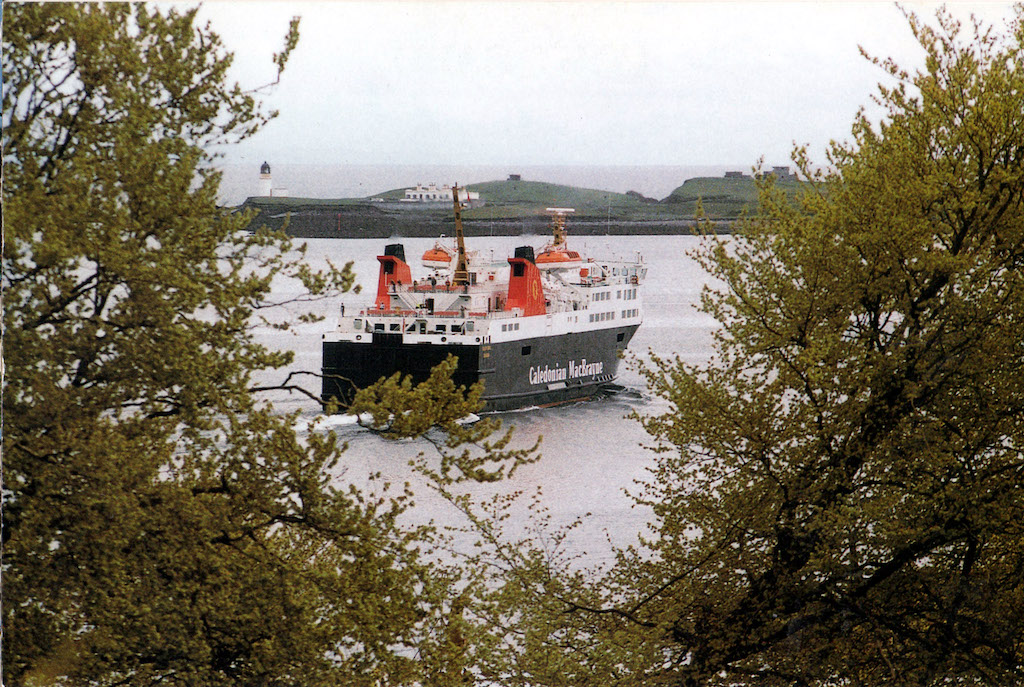
Among Sue Anderson’s postcards of Isle of Lewis at Stornoway is this imaginative view of the vessel with Arnish Lighthouse behind
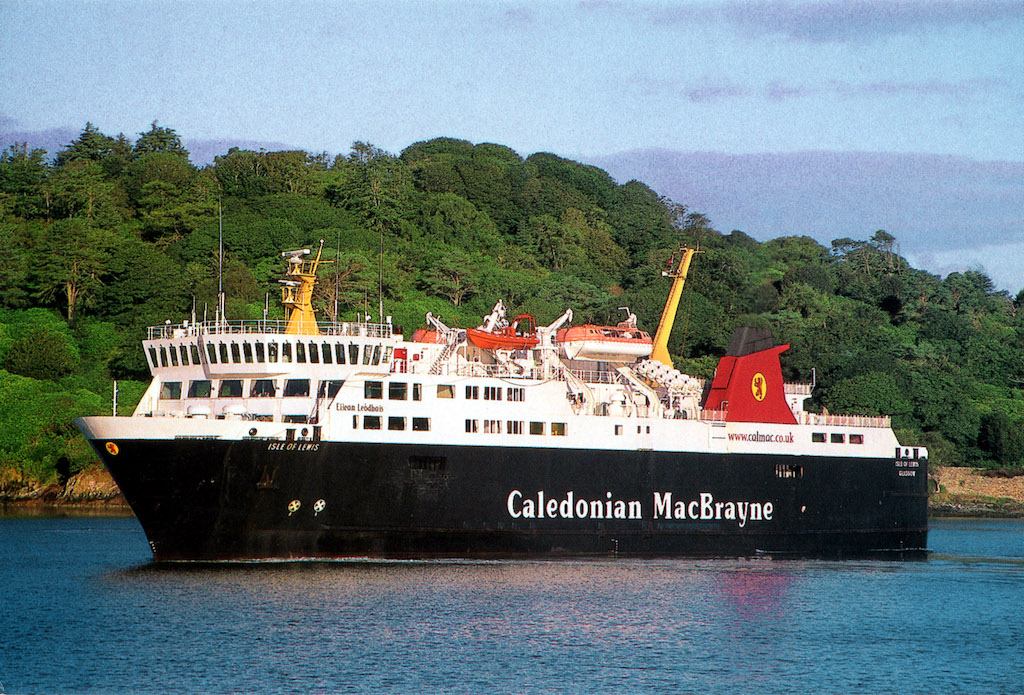
This is probably the best postcard profile of Isle of Lewis during her stint on the run for which she was built — an Island Blue product
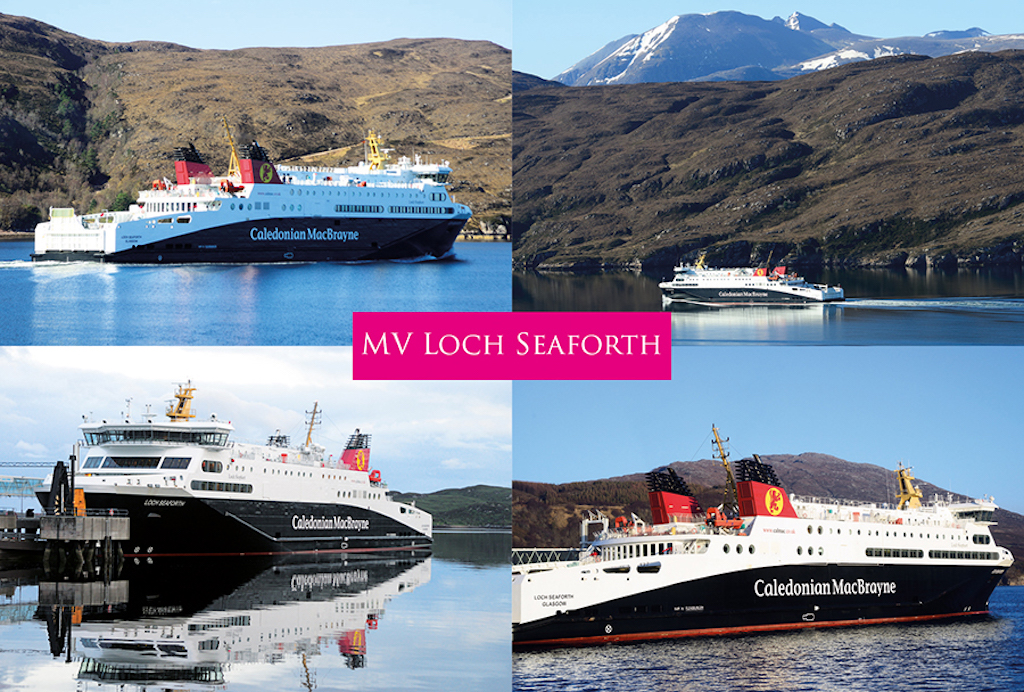
An Island Blue multi-view of Loch Seaforth — one part of which (below) shows her to advantage amid the snow-capped scenery of Loch Broom. She replaced Isle of Lewis on the Stornoway-Ullapool service in 2015
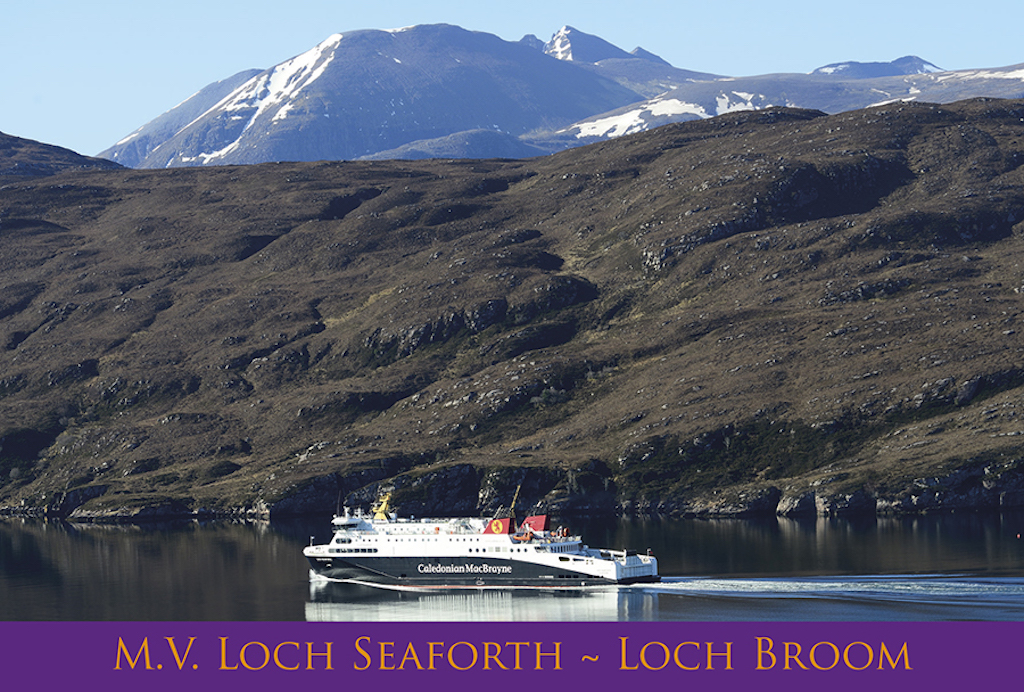
PREVIOUS POSTS BY JOHN PARK:
Battling a southerly swell in Millport Bay (2020)
King George V’s last public cruise (2020)
Postcards from the Uig triangle (2020)
How about joining CRSC? You can do so for just £10 by clicking here — and you’ll receive all the benefits, including our annual Review of west coast ship movements, a 54-page colour magazine, discounts on photo offers and access to photo-rich ‘members only’ posts.
Published on 11 December 2020












